For the project “Journey to the Center of Europe”, I am going to visit all the places that have ever laid claim to being the geographical center of Europe or the European Union. And write about them.
This time, we are going to visit a country which half of you will miss on your road trip around Europe, because you will confuse it with Slovenia. We are going to Slovakia, though. But then, it doesn’t really matter where you end up, because both of these countries are among the most beautiful ones in Europe.
Many of the places that claim to be the geographical center of Europe are surprisingly out of the way.
The train ride to Kremnica in Slovakia positively celebrates this remoteness. At about 50 km/h, the train puffs up a winding track, going nothing but uphill. I’m deep in the mountains. Deep in the clouds even. The train stops at lonely stations, from where passengers still have to walk several kilometers to their mountain villages. Each time the train doors open, the air blowing in feels a few degrees colder. A couple wraps a blanket around their dog for protection.


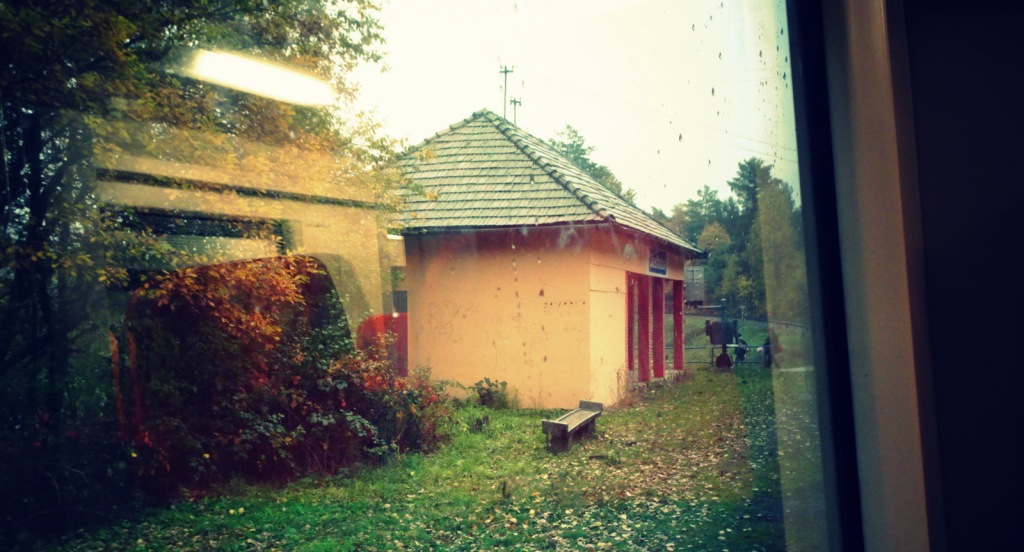

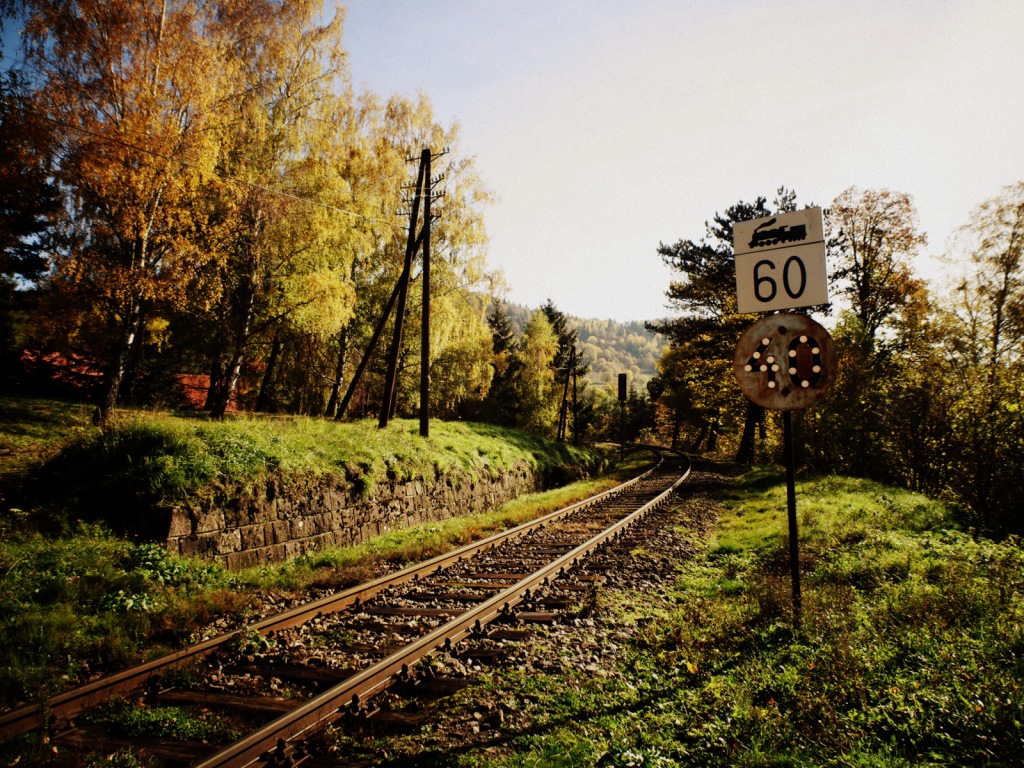
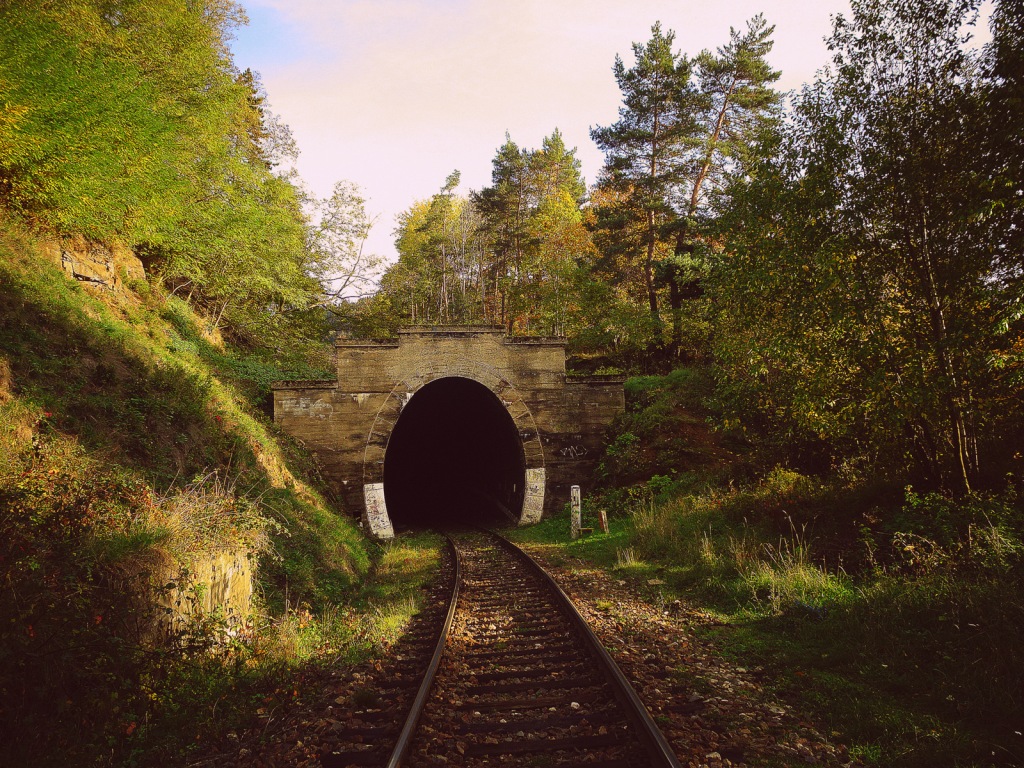
After one hour on the train, I have covered the 35 kilometers from Zvolen to Kremnica.
The walk from the station to the town takes another hour and is even steeper than the railroad. But now it’s downhill, because the town lies in the valley, while the railroad steams from peak to peak in an engineering feat reminiscent of the Semmering Railway. I don’t know if this is very practical, but it does allow an overall view of the town and the surrounding scenery. Both of them equally appealing.

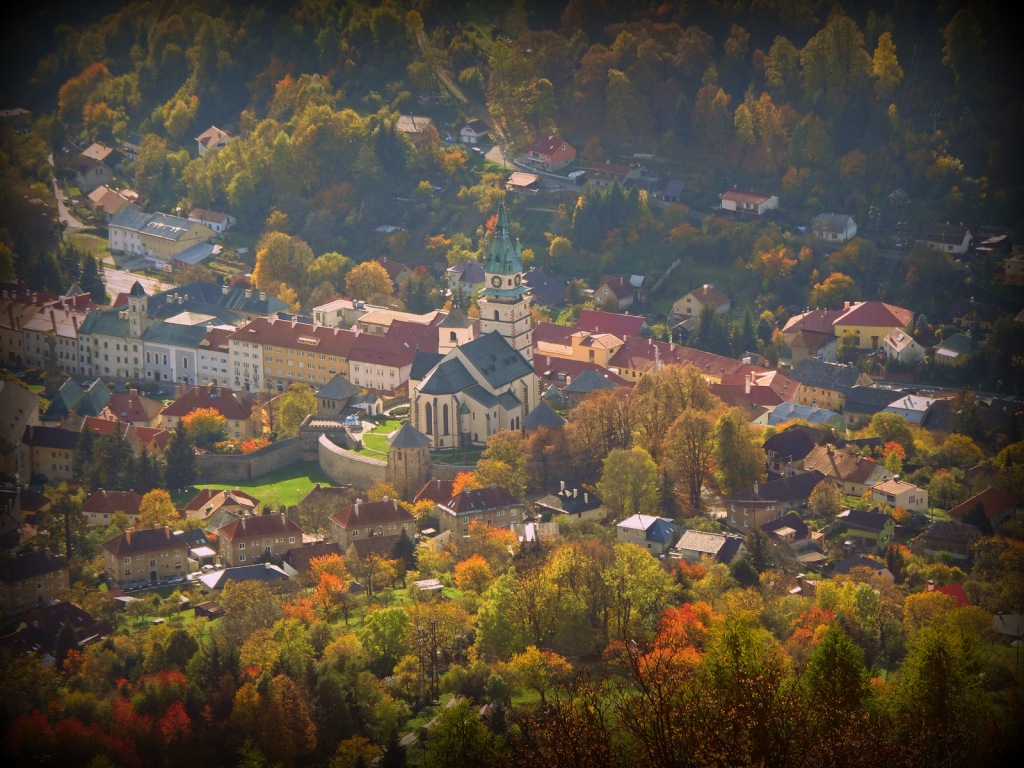

The difference in altitude between the town and its train station is almost as much as in La Paz, where you have to traverse an entire kilometer of difference in altitude, and thus difference in temperature, even climate, between the lowest and highest parts of the town. But in La Paz they have cable cars for that purpose. Not so in Kremnica. The people here must be quite athletic.



The path from the station to the town is so long, steep and far that it is lined with small rest houses. Unfortunately without catering. Experienced travelers would have brought provisions, but I am proof that you can travel a lot and still make the same mistake over and over again.
It’s a Saturday afternoon and all the stores are already closed. The supermarket: closed. The bakery: closed. The little grocery store on the other side of a small stream: closed. The whole town seems deserted.





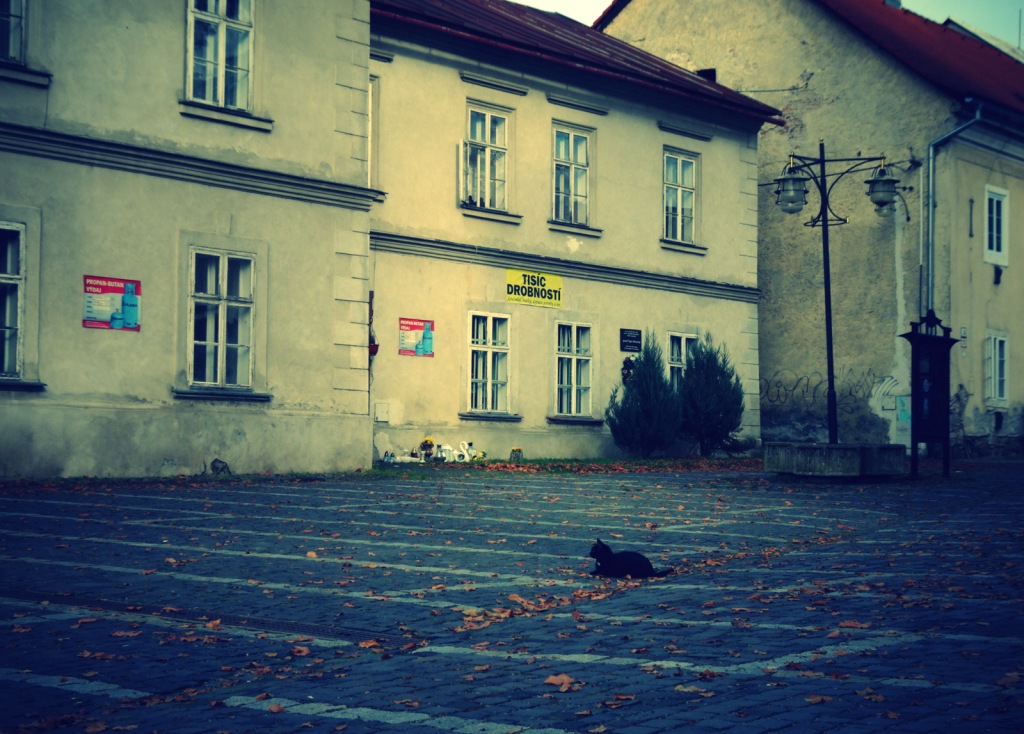
Only two houses have lights in them, the town hall and the cultural center. And only one chimney is smoking, on the cinema. I like that, especially because, according to the relief on the wall of the cinema, they are still showing communist partisan movies.




Here I could get to know the local intelligentsia. But, as my colleague Bertolt Brecht put it: Before culture, you need to consume some food. A walk through the empty town, which ends in front of many closed shop doors and with a desperate look at the opening hours advertised there, reveals that a different biorhythm prevails in the mountains. The stores here open from 5:30 a.m., but close early in the afternoon.
I’m already preparing to survive a whole night solely on fresh mountain air and the books I’ve brought with me, when, on my way to the accommodation, I notice one small store still offering its wares beyond the otherwise locally accepted operating hours. It’s the liquor store. Or rather the one liquor store that has taken over the 24-hour emergency service for today.

“Better a beer than no calories at all,” I am thinking to myself, confident that Bertolt Brecht must have said something similar once. And then, between all the casks and kegs, the girl behind the counter even finds a bag of chips. Hallelujah!
The next morning, the clouds have cleared, the rain has evaporated, the cold has given way, and Kremnica lies before me like a fairy-tale town in perfect sunshine.


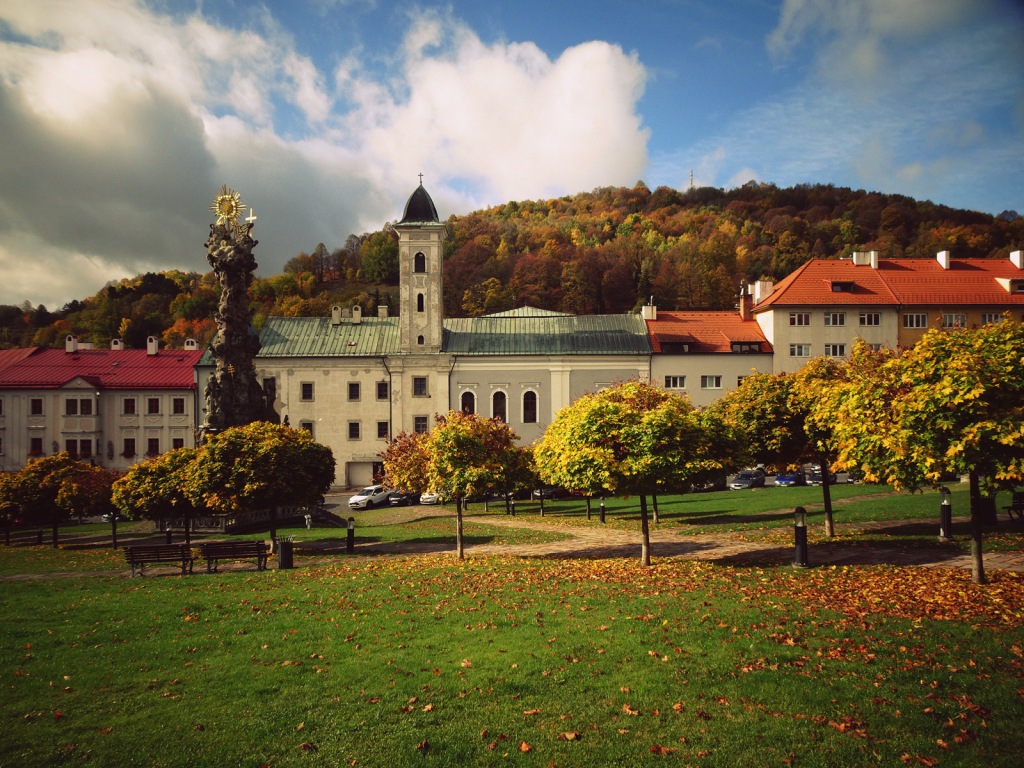
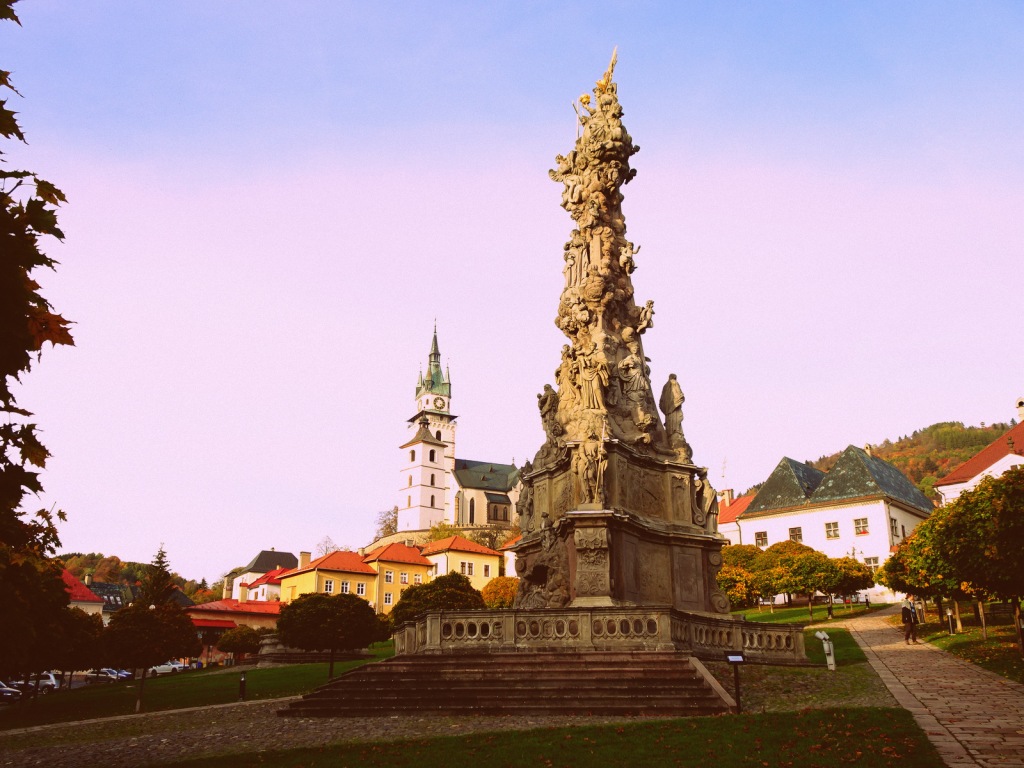

This is it, golden October, perhaps the last beautiful days of the year. I should be looking for the geographical center of Europe, that’s why I’m here, that’s what you came along for. It’s supposed to be by a small church a few kilometers outside of Kremnica. Very officially, confirmed by Romano Prodi. (If you don’t know him, you are too young for this blog. Sorry).

However, this highly significant place will have to wait. Because I feel more energy than I have in weeks, and an irrepressible desire for nature and for hiking. Kremnica is surrounded by mountains, each of them more tempting than the next.
But only one is called Kalvária.

A word that can be understood in any language, thanks to Latinization and Christianization. I do not want to descend from the high intellectual horse down to common hiking tips, but one thing I have learned during my wanderings around the world: Where there is a Mount Calvary, you better climb up and enjoy the spiritual edification (for Christians) or the beautiful view (for atheists, agnostics, pagans and heretics). In fact, Christians can also enjoy the view, as long as they are not puritans.

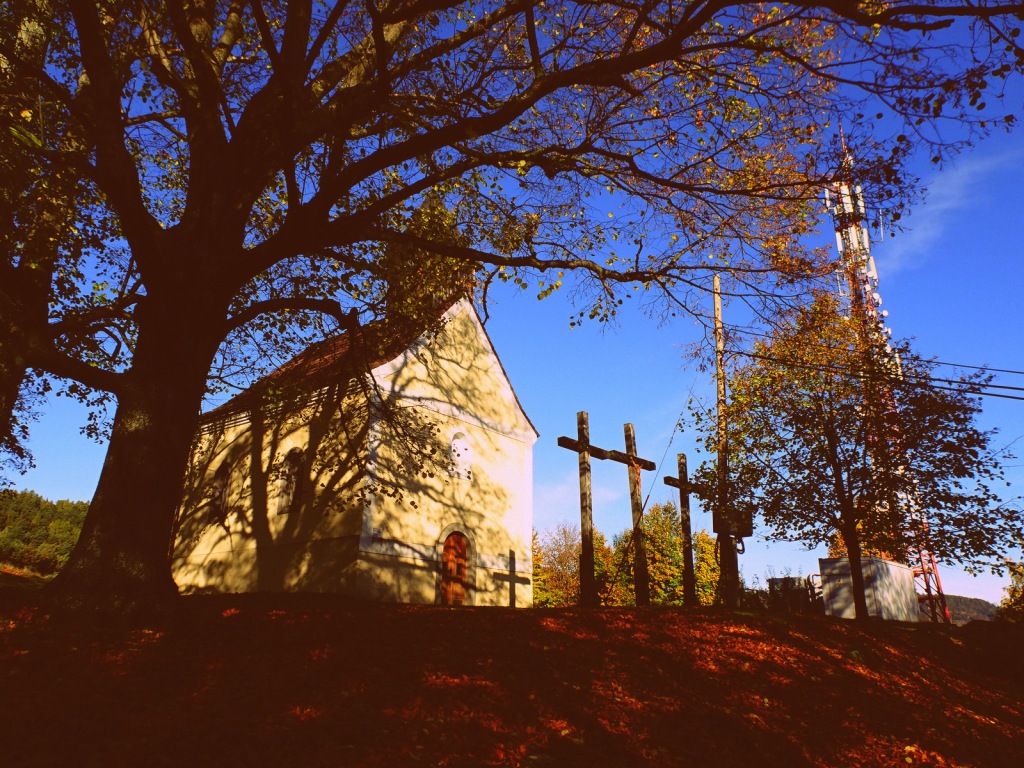
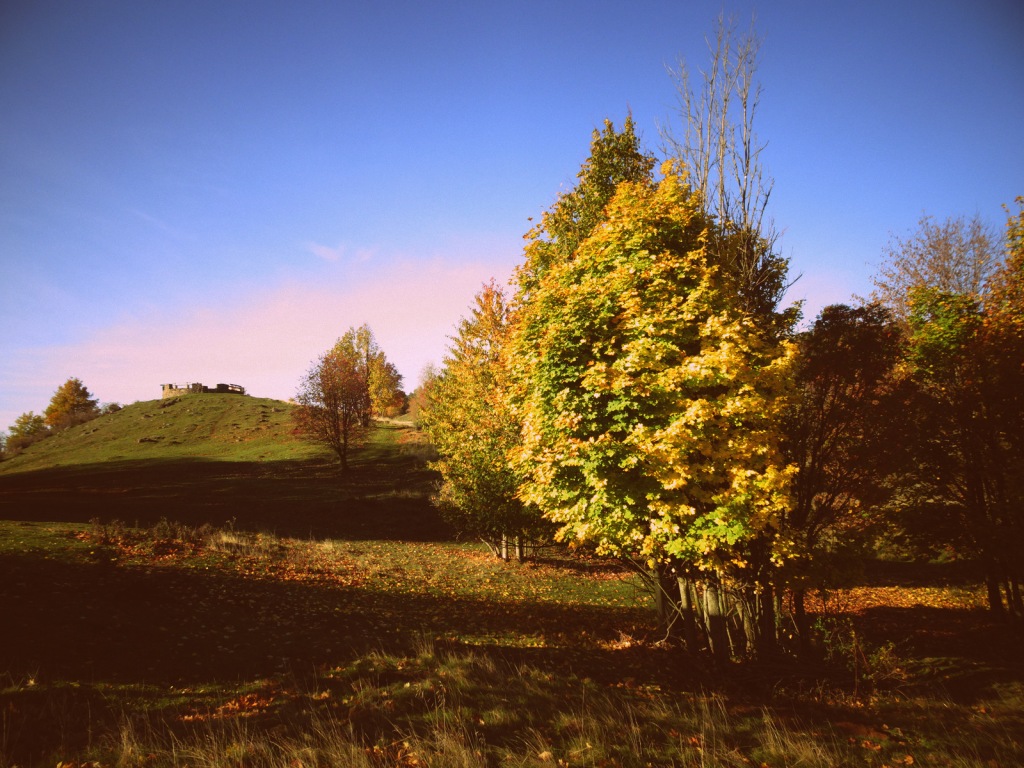
The view from Golgotha is wonderful, that much even Jesus knew. A sea of clouds retreats slowly between the perfectly curved hills, as if it wants to reveal the beauty of Slovakia very carefully, so that I – and presumably most of the readership – is wondering why we haven’t visited the Kremnica Mountains, the Great Fatra, the Western Carpathians and Slovakia before. Especially as it is so easily accessible, right in the center of Europe.

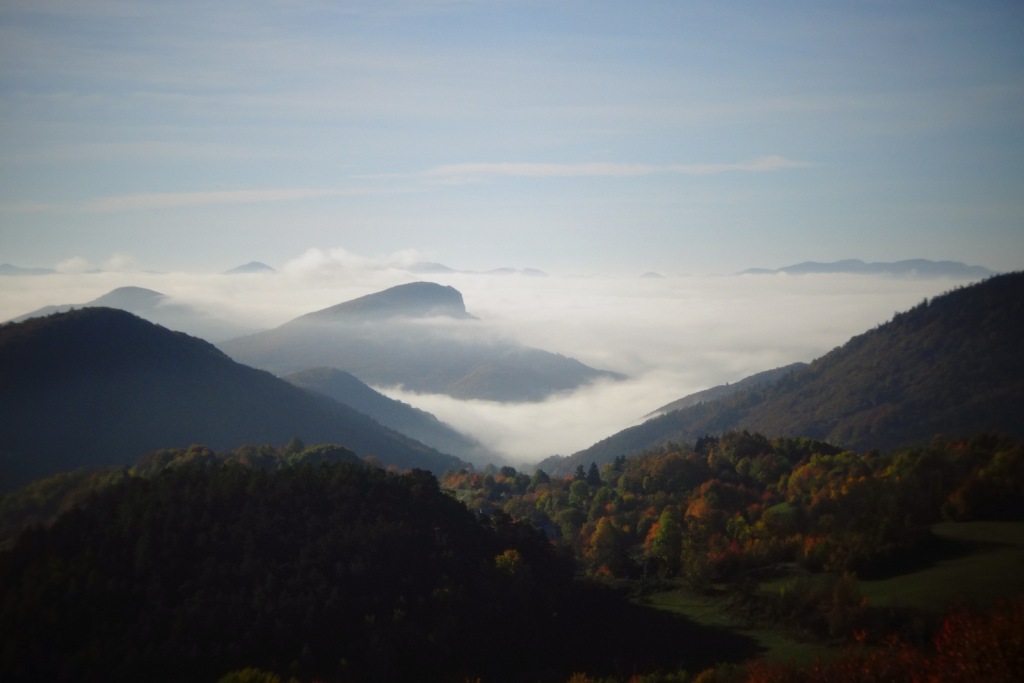
Ah yes, the center of Europe, that’s why we are here after all: Far away on the horizon, to the north, I spot a small church that looks suspiciously like the exact and geodesically determined point without which I would never have come to this intoxicatingly beautiful place.
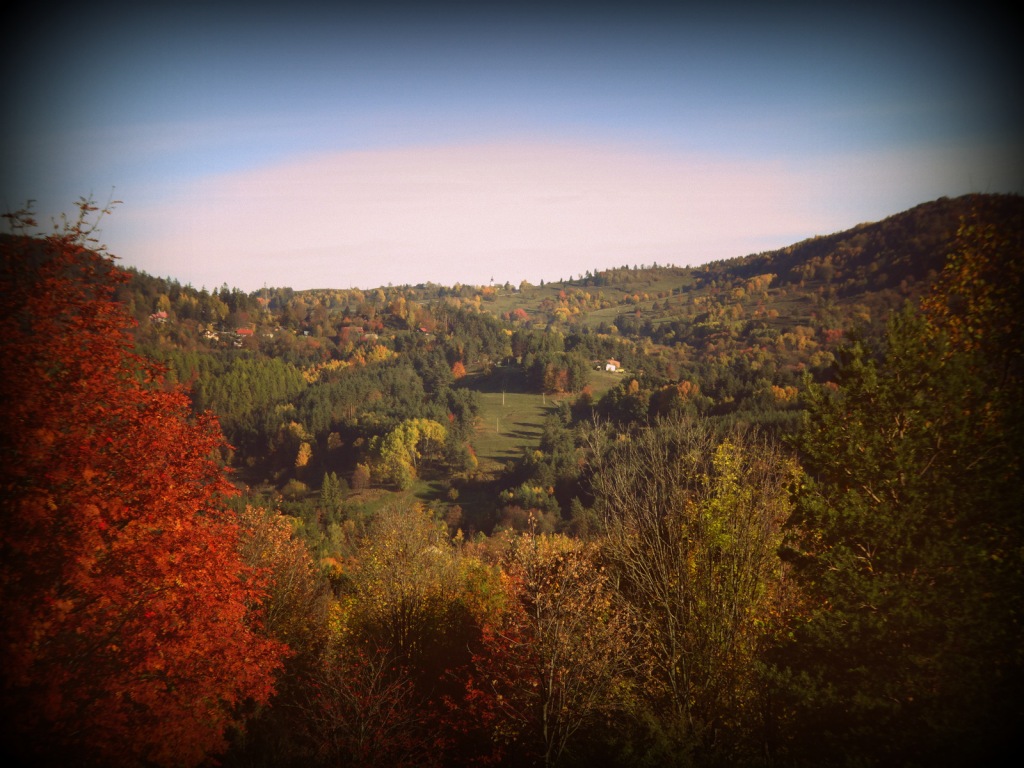

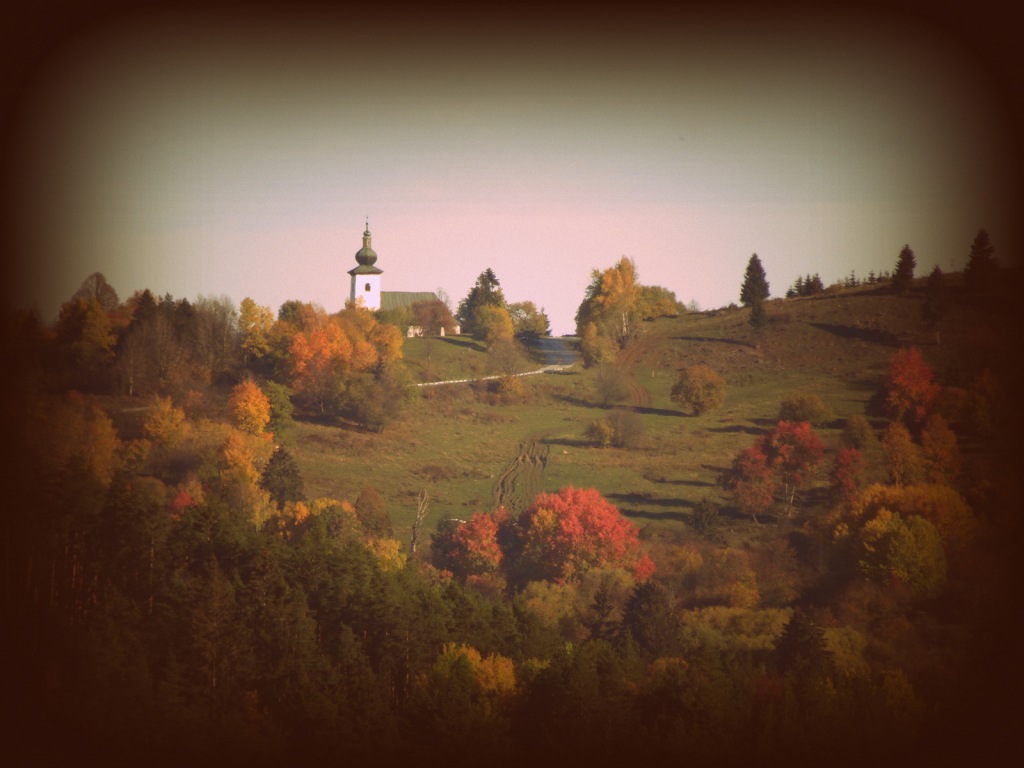
Whatever you can spot with the naked eye, you can also hike in one day. Hopefully, the photos give you an impression of the following hours, which I was walking through forests and across hills, with a general uphill tendency towards Kremnické Bane.









In the small church there I learn that the village is also called Johannesberg, a German name. The inscription of the stations of the cross is bilingual, Slovak and German. The outline about the history of the church is bilingual, Slovak and German. The war memorial is monolingual, German only. It was the Germans and Austrians who wanted World War I, but the Czechs and Slovaks ended up with their own country as a result.
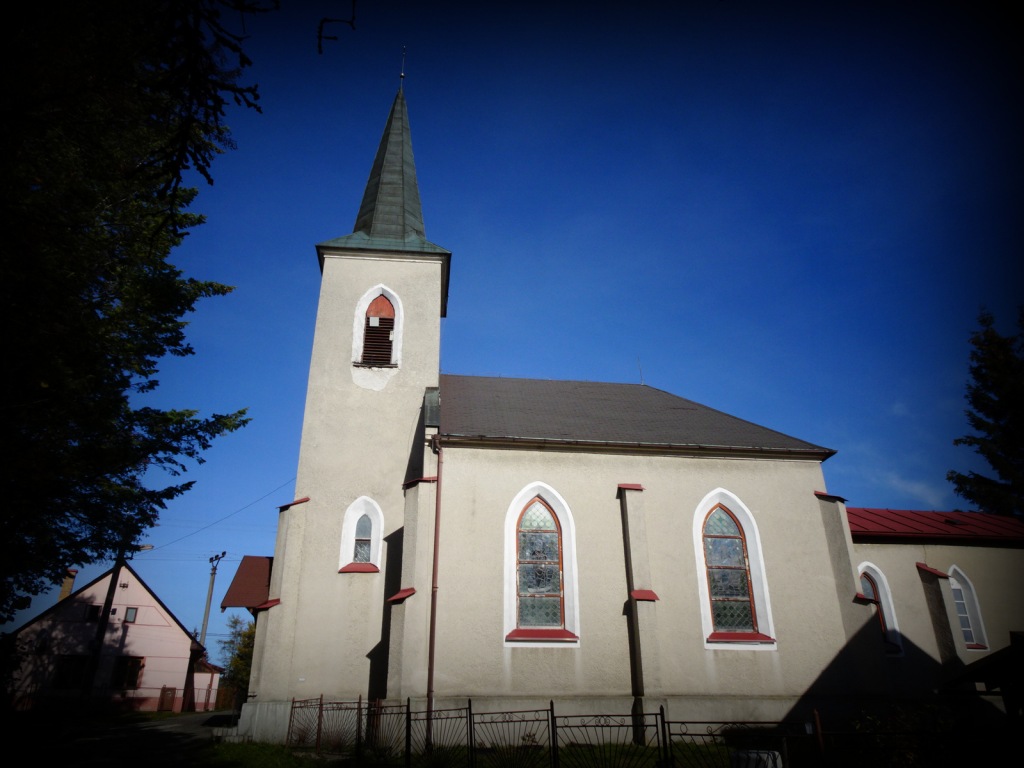


It was also the Germans and Austrians who wanted World War II. At the end of that one, they were expelled from Czechoslovakia, out of revenge. At least most of them. Near Kremnica there is said to be a village where even today, so many Germans live that German is the second official language: Krahule (in Slovak) or Blaufuss (in German).
But first, let’s get to the final climb to the little church where I suspect the geographical center of Europe to be. I am excited, but don’t expect too much, because some of these carefully measured midpoints are quite unspectacular. It’s probably like reaching the North or South Pole after you’ve struggled 2,000 km through ice and snow. And then there’s just a little menhir in a field.

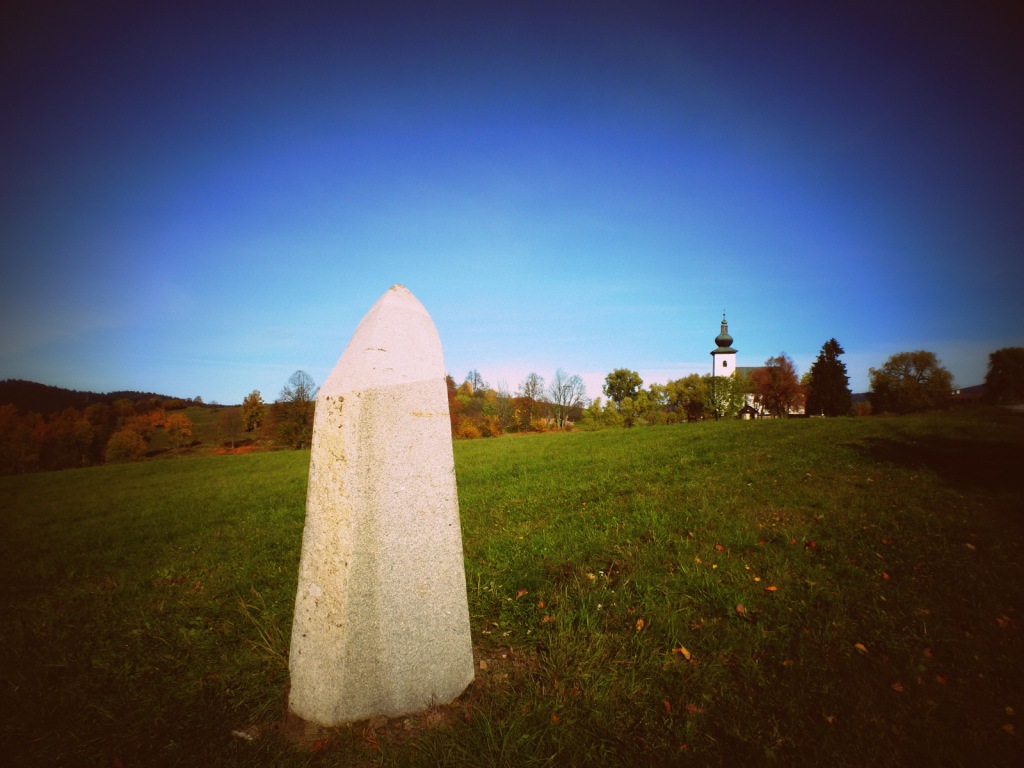
But what a view!
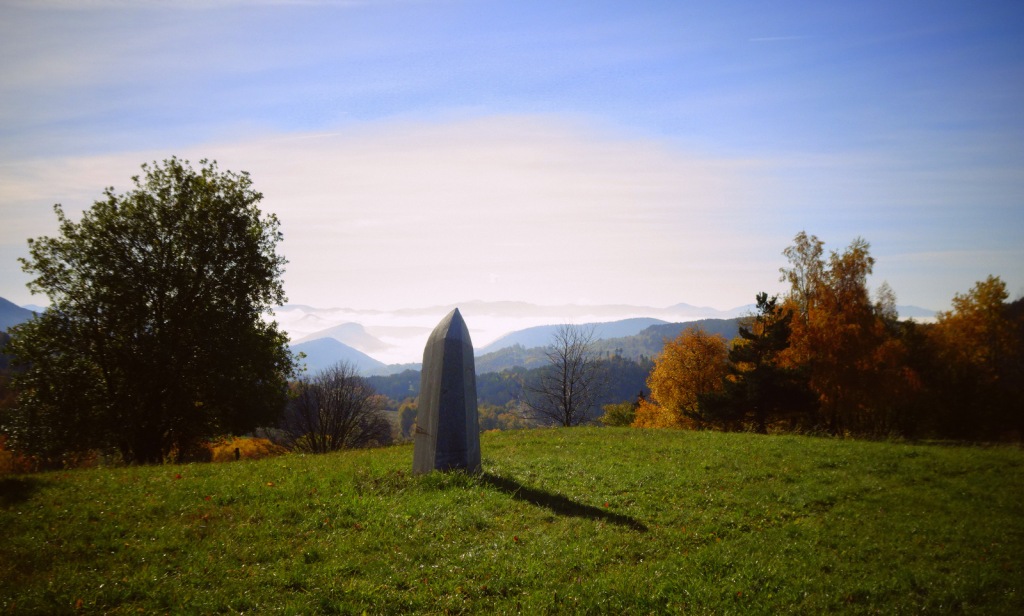
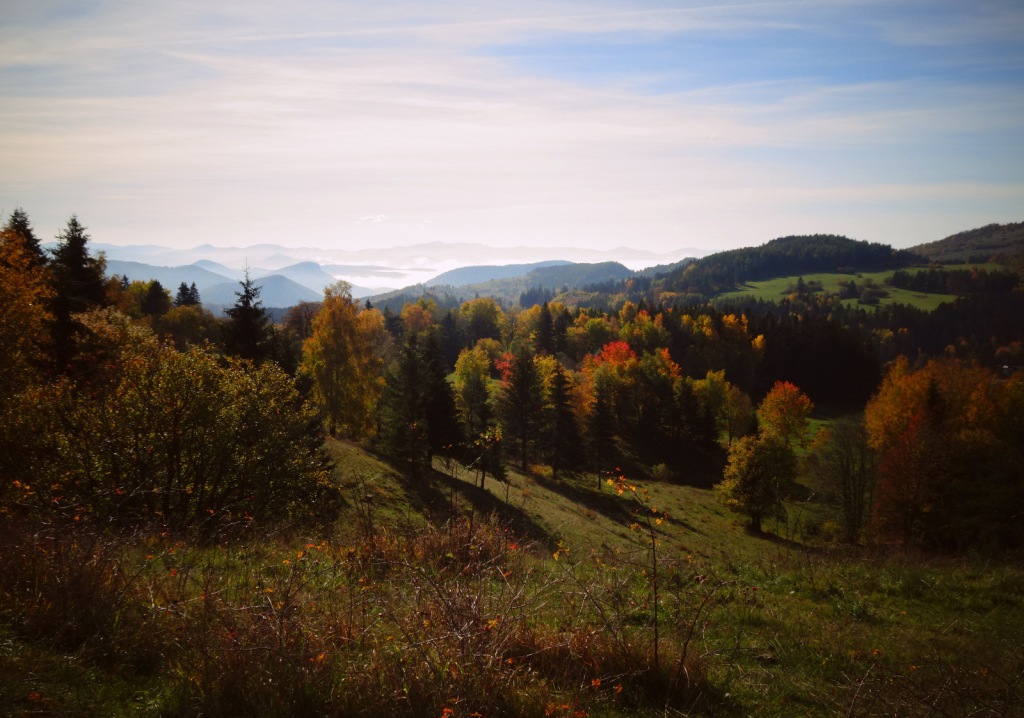
Strictly speaking, if you want to believe in such suspicious coincidences, the geographical center of Europe is exactly where the church is located. Details are not given, but a sign claims that this is the oldest center of Europe. So it probably dates back to a time when people didn’t even know how far Europe extends, possibly before the discovery of the Canary Islands or the Azores.



The church itself is also a central point. It stands on an open field because the five surrounding villages could not afford their own church in the 14th century and therefore built a communal church on this equidistant point. I praise such frugality and cooperation. Better than today, when not only every village, but also Catholics, Protestants, Unitarians, Mormons, Baptists, Seventh Day Adventists, Jehovah’s Witnesses, New Apostolics, and the Brotherhood of the Holy Spirit each want their own church.
Even the esotericists have already been here, because another sign in front of the church warns:
Here you can see yourself as you really are. As the centre of your life. As the centre of all the action around you. Material and spiritual. Your life is all yours. Live it. Stop waiting for a more suitable moment. The best moment is now. The best place is here. Start. Live. As Barbora lived. Her decisions resulted in torture and death. Your decision may mean for you the beginning of a new life. It may be filled with struggle, fight against your embodied patterns of behaviour.
Among all esotericists, Christian esotericists are the most annoying ones. They always want to crucify or torture or stone someone to death. And it seems to me that we already have far too many people who think of themselves as the center of the universe. That’s a worldview which really doesn’t need more encouragement.
But there is also an official memorial stone. And a fountain, spouting euro coins, unfortunately already turned off for winter. Financially, I always have bad luck on my trips. Well, it’s going to be another hobo lunch then, instead of a business lunch. But a very comfortable one, lying in the meadow, listening to the twelve o’clock chime, enjoying the sun, and letting all doubts about the validity of the local claim to be the center of the continent to be whisked away by the clouds. I am just happy that this absurd project led me to discover one of the most beautiful places in Europe.






On the map, I see that the aforementioned village of Krahule/Blaufuss is only a few kilometers away, always uphill. I try to hitchhike, but none of the drivers stop. The man on the bicycle does not stop. The girl on the horse does not stop.

So I finally reach Krahule/Blaufuss on foot, where I have to realize that my information seems to be outdated. I do not catch sight of any signs in German. No sign of “Blaufuss”. The sign with the history of the place is exclusively in Slovak. As is the sign pointing to the petting zoo. The only thing in German are the gravestones in the cemetery.


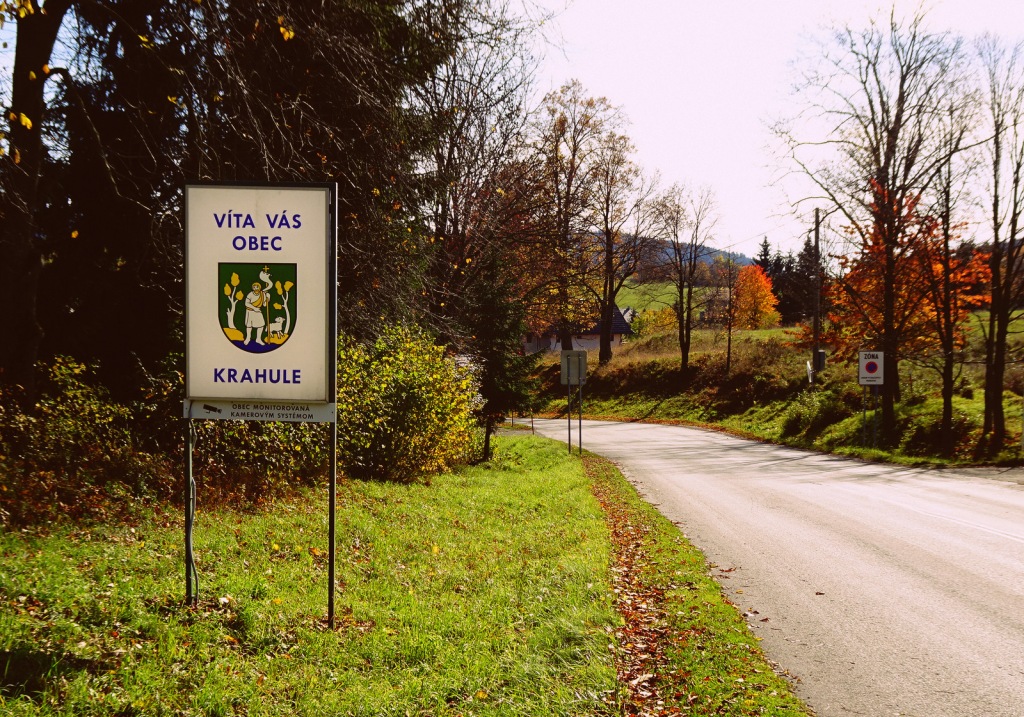


I can’t read the sign with the bear, but I guess it asks hikers to take some food for these cute animals when walking into the forest. Therefore – and because I am already quite hungry myself – I look for a shop or a restaurant. To no avail. The only thing I discover is a small pub. Two men are sitting over what seems to be neither their first nor their last beer of the day. On the TV in the saloon, they are watching the James Bond movie “Quantum of Solace”, dubbed in Slovak or Czech. I don’t even know if there is much difference between the two languages. Probably not. After all, the two peoples and parts of the country must have understood each other well before their amicable divorce in 1992. Maybe this is one of those job-creation programs for translators, like the splitting of Serbo-Croatian into four languages.
In any case, I ask if there’s something to eat.
“No,” says the girl behind the counter.
“Too bad,” I say, but this discreet reference to my empty stomach doesn’t make the young lady reconsider her gastronomic offer.
“Do you have a Coke?” I ask, trying to get at least a few colaries.
“No,” says the barmaid, “we only serve alcoholic drinks.”
The two James Bond fans chuckle.
“I see a bottle of Coke behind you,” I remark with my eye trained on discovering Coca Cola even in the farthest corners of the world.
“That’s for Whiskey and Coke,” the beverage specialist replies in a tone as if the consumption of unadulterated Coca Cola is against the law. The grim look on the faces of the two men in lumberjack shirts does actually suggest a violation of some unwritten municipal regulation. “Kanun” is what we experts call it, and it can end up deadly.
Only my reference to the hike of several hours, which I have both behind and ahead of me, softens the rules, and I am granted a small ration. There will probably be a little more whiskey in the Whiskey and Coke later tonight. But I can’t imagine that anyone will mind.
Krahule/Blaufuss is a small village. There is not much going on here, but the ski lifts promise that this will change in the winter months.
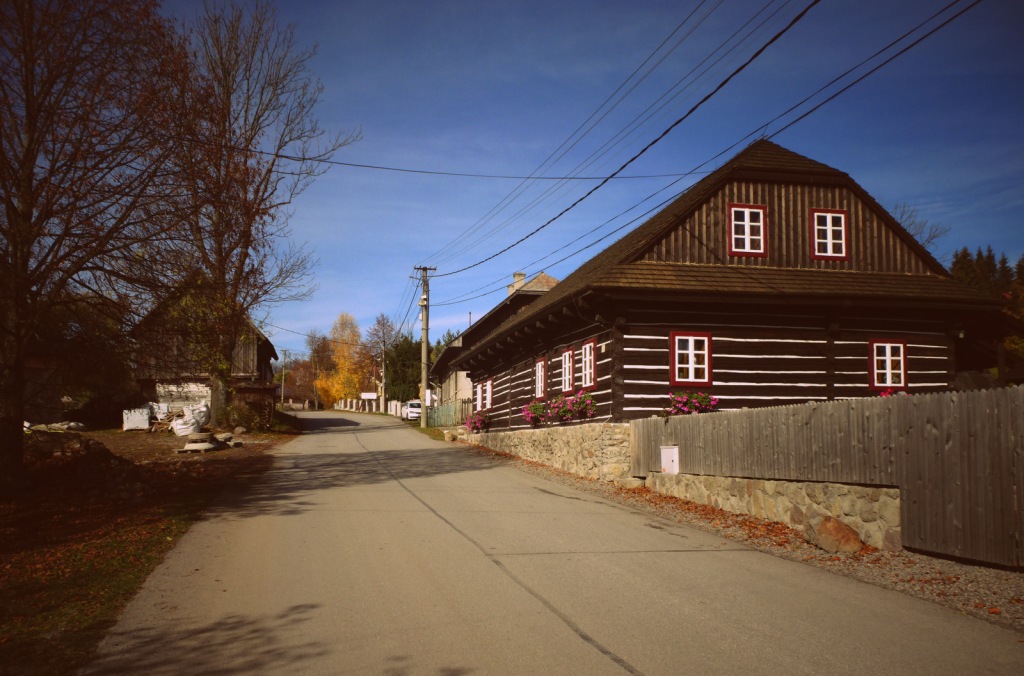


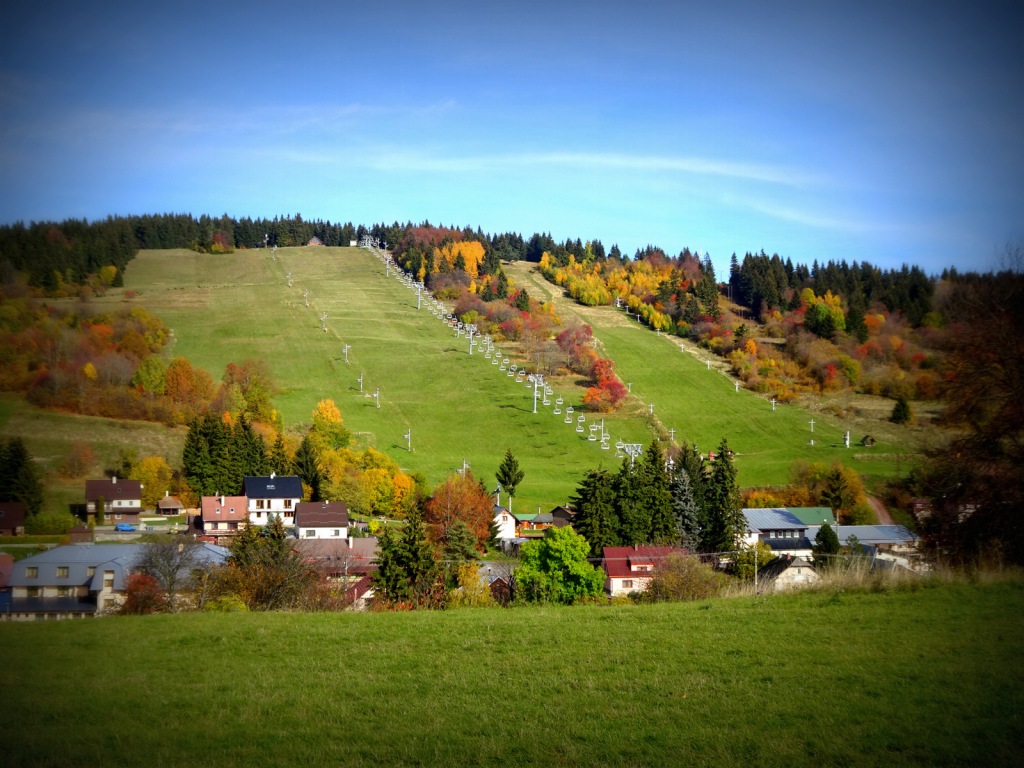

Unless climate change interferes and the skis can only be used for decoration.

If you know my blog, you know, fear and often curse that my wanderings are merely a pretext for historical digressions. I have already touched on the history of Czechoslovakia elsewhere (for example in Plzen or in the article about Švejk). Especially in Kremnica, whose population before World War I consisted of one third Slovaks, one third Hungarians and one third Germans, there would be the perfect opportunity to talk about the German-Czechoslovak relations, from the Sudeten crisis to the expulsions after the so-called Beneš decrees.

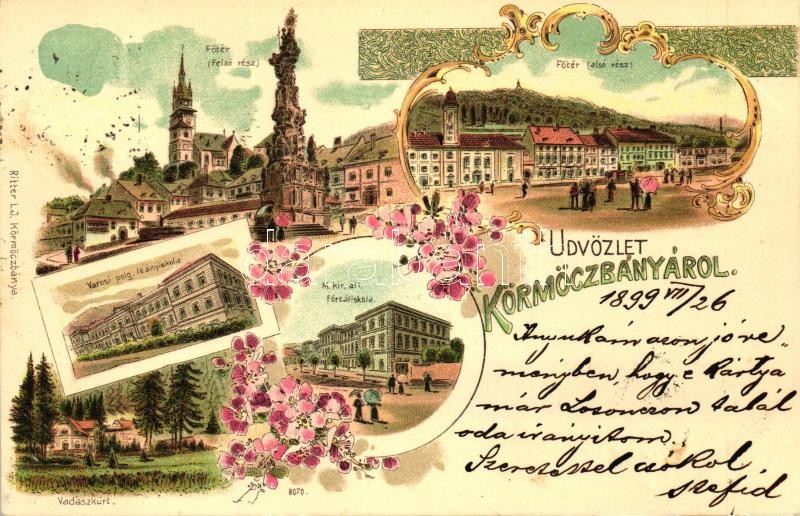
But because an amazing number of centers of Europe are located on the territory of the Czech Republic, there will be plenty of reason to do so. And the Hungarian Trianon trauma will soon get its own article anyway.
Besides, the attentive ones among you have already spotted during the hike that there is another topic of outstanding historical importance in and around Kremnica: mining.


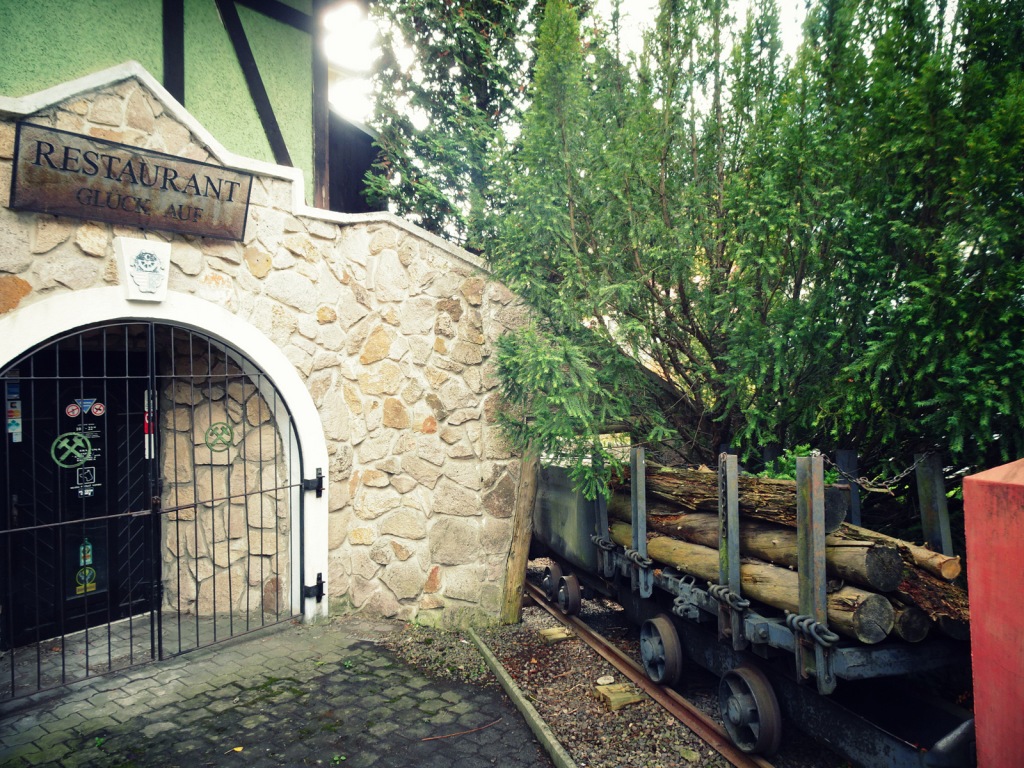
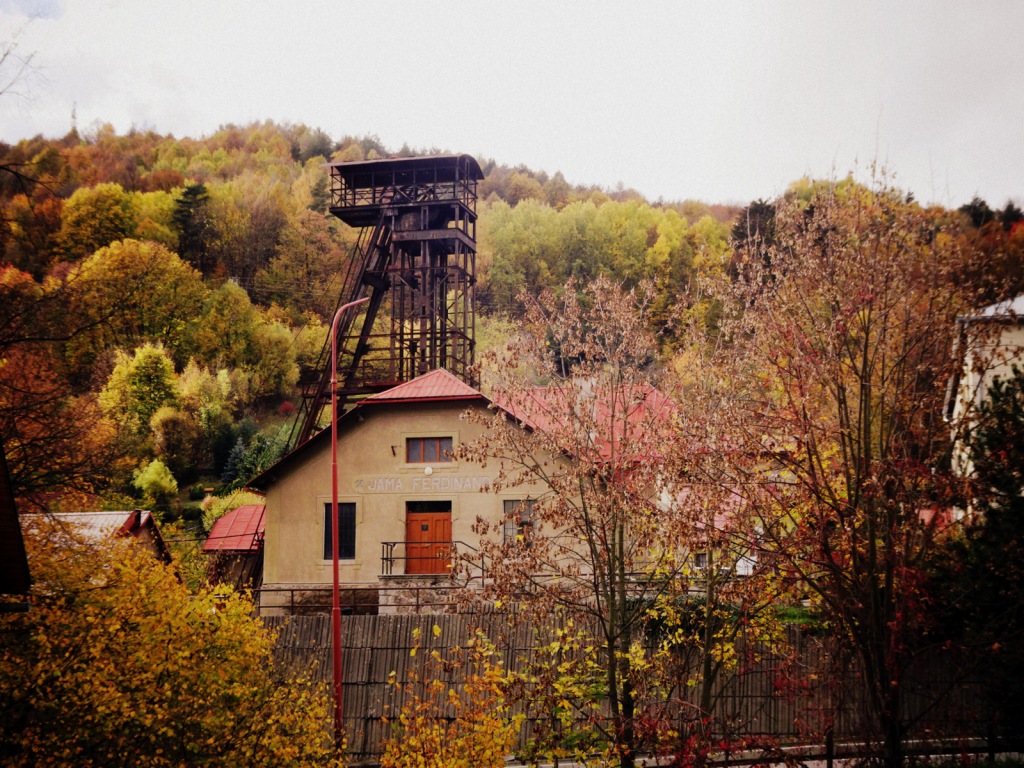




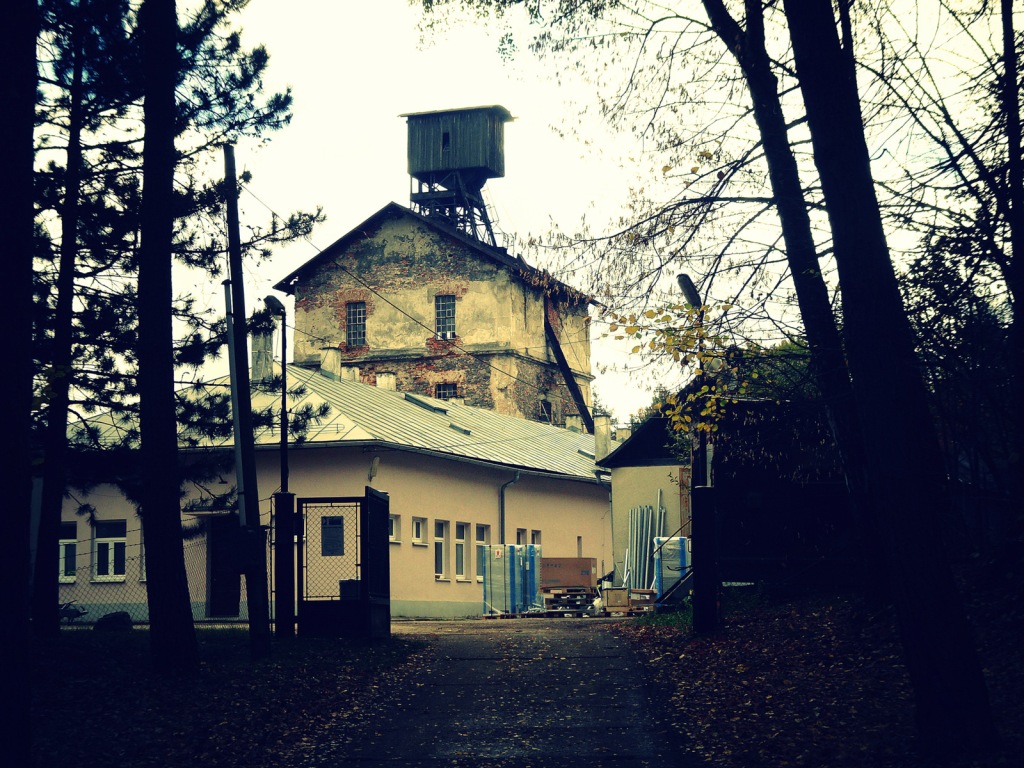

But before we descend into the dark and humid depths of the earth, a few photos from the hike from Krahule/Blaufuss back to Kremnica/Kremnitz/Körmöcbánya.
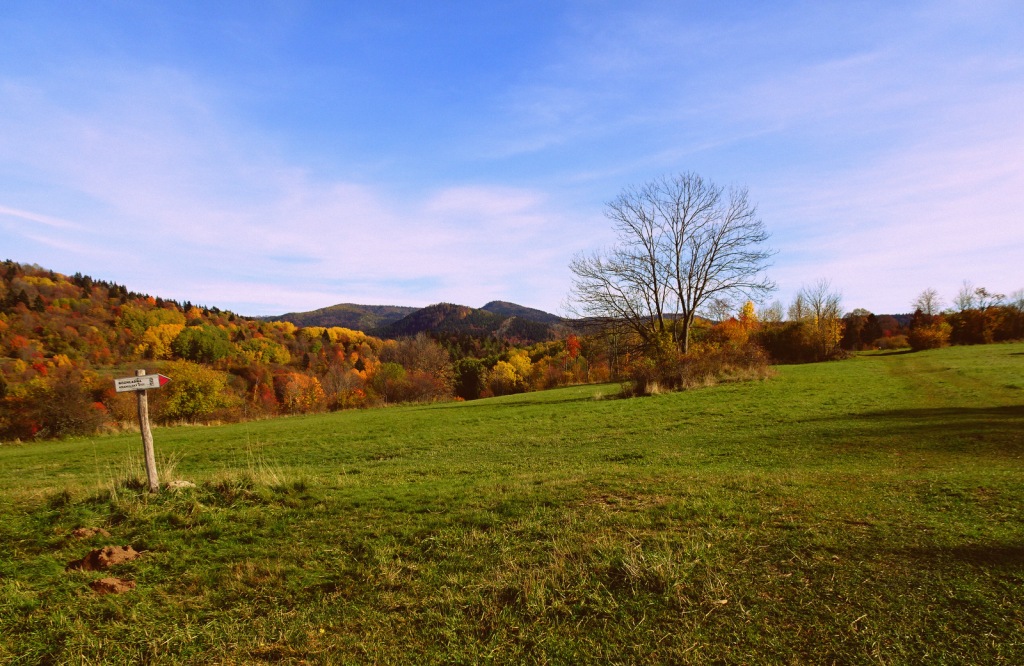


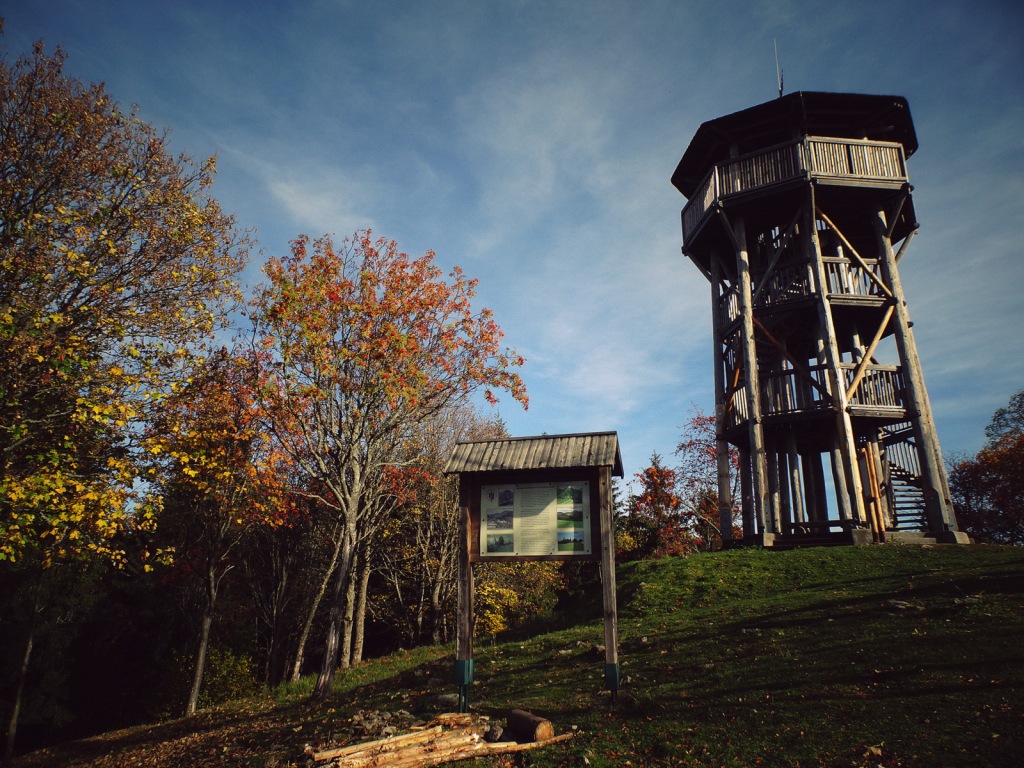




In this region, you can walk in any direction, climb any mountain, you just can’t find an unpleasant spot! I didn’t meet any of the promised bears, though. Too bad, because I get along quite well with these cuddly animals. But then I should, after all I work with animals professionally.
Less professional is my approach to the concept of getting to the point quickly, because it is only now, after more than 2,000 words have been spilled and wasted, that I mention why Kremnica is so important. Or used to be important. Back in the Middle Ages, in the good old days, when you weren’t bugged with Bitcoins, but real coins were jingling in your pocket with every transaction. Because Kremnica wasn’t some random mining village like Coober Pedy or Manchester. No, in “golden Kremnitz,” as the town was called at the time, they mined the really valuable stuff: gold and silver.
And tons of it.
From 170 shafts, 110 adits and 205 kilometers of tunnels, so much gold was mined in the most productive period that up to 500,000 gold ducats were minted in Kremnica every year. In the mid-14th century, 80% of Europe’s gold came from the mining towns in what was then the Kingdom of Hungary, most of which are located in what is now Slovakia. After the city of Florence, the coins were called Florentines, practically something like the euro of the 14th century. The word lives on in today’s Hungarian currency, the forint, albeit with slight problems of inflation.

One of these towns, Banská Štiavnica, is even a UNESCO World Heritage Site.

No idea why Kremnica was not given the same honor. Because it is at least as pretty, as I can convince myself on many walks around town.




For the best view, one can climb the tower of the city castle, which sits on a hill within the city, surrounded by a fully preserved ring of walls. To climb the 127 narrow steps, a museum employee unlocks an iron gate – and closes it again right behind me. “If you want to get out, pull the bell. But in 20 minutes, I’ll be taking an hour lunch break. If you miss that, you’ll have to wait on the tower.”





I hurry up, because I don’t feel very comfortable in such windy and lofty heights. That’s why on this blog, there are no reports of balloon rides, flights with airships, and only rarely a trip to the high mountains. I prefer to stay on the ground, in keeping with my humble character. (With the one exception where firefighters in Brazil gave me a ride in a helicopter. But that’s another story.)
But I wanted to tell you about the history: Mining in this region flourished, making first the kings of Hungary and then the Habsburgs rich, gilding churches and palaces throughout Europe, and establishing the tradition of minting coins in Kremnica that continues to this day.
Gold is no longer mined, but the coins of Czechoslovakia have been minted here, Slovak crowns since 1993, and 500,000,000 Slovak euro coins since 2008. (You may not have noticed it if you only pay with electronic or paper money, but the backside of the euro coins are minted separately by each euro-using country. Except for Kosovo and Montenegro, but their use of the euro is semi-legal at best anyway.)
In addition, the local mint has already minted coins for Poland, Romania, Greece, Cuba, Mongolia, Algeria, Tunisia, Guinea, Sudan, Senegal, Mali, Cape Verde, Lebanon, Iraq, Slovenia, Bangladesh, India, Mauritania, Cyprus, Albania, Russia, the United Arab Emirates, Israel, Qatar, Nepal, Somalia, Andorra, Congo, Panama, the Cook Islands, North Korea, Namibia, Liberia, Hong Kong, Belgium, Spain, France, the United Kingdom, the United States, Norway, Argentina, Malaysia and Germany.

Having said that, mining in Kremnica went downhill since the 16th century, or the 17th century at the latest. The deeper people were drilling, the more complicated it got. (Like at the dentist.) Shafts and tunnels collapsed or filled with water. And politics got more complicated, too.
As you know, the Thirty Years’ War began in 1618 because the burghers of Bohemia wanted a wee bit more autonomy within the Habsburg empire. The emperor however didn’t want to hear anything about that, preferring to set all of Europe ablaze.
War costs money, and a Thirty Years’ War costs even more money. If it had been up to the people of Kremnica (and the other mining towns in Bohemia, Moravia and Silesia), they naturally would have denied the emperor and the Reich the money used to wage a war against themselves. After all, one can easily flood a mine “by accident”. Or blow it up. Or go on strike and sing protest songs.
In other words: Here, in this town, the Thirty Years’ War could have been averted.
Except that unfortunately, just a few years before, America – and within America, plenty of gold and silver – had been discovered. It was the Spanish who bogarted all that wealth, but the Spanish king Philipp III was also a Habsburg and a cousin or something like that of emperor Ferdinand II. And thus, the Spanish gold and silver from the new world financed thirty years of war in the old world.
Golden Kremnitz was superseded in its importance for the world economy by Potosí in present-day Bolivia, which I therefore also scouted out as part of this research. I even went into the mines myself, under the most dangerous conditions, with a backpack full of dynamite and surrounded by miners (and minors) who, under the influence of alcohol and coca leaves, blasted, hammered and risked their and my lives.

In Kremnica, I should now also seek out abandoned tunnels and dig for gold and stories. Or even, like the more scientifically minded colleagues from the “Journey to the Center of the Earth”, go looking for rhombohedral crystals, retinasphaltic resins, gehlenites, Fassaites, molybdenites, tungstates of manganese, and titanite of zirconium. At the very least, I should visit the archives, the museum or the local library.

But it’s a warm, sunny day at the end of October. Probably the last one this year, before the fog descends and winter hits.
So I go to the park instead.

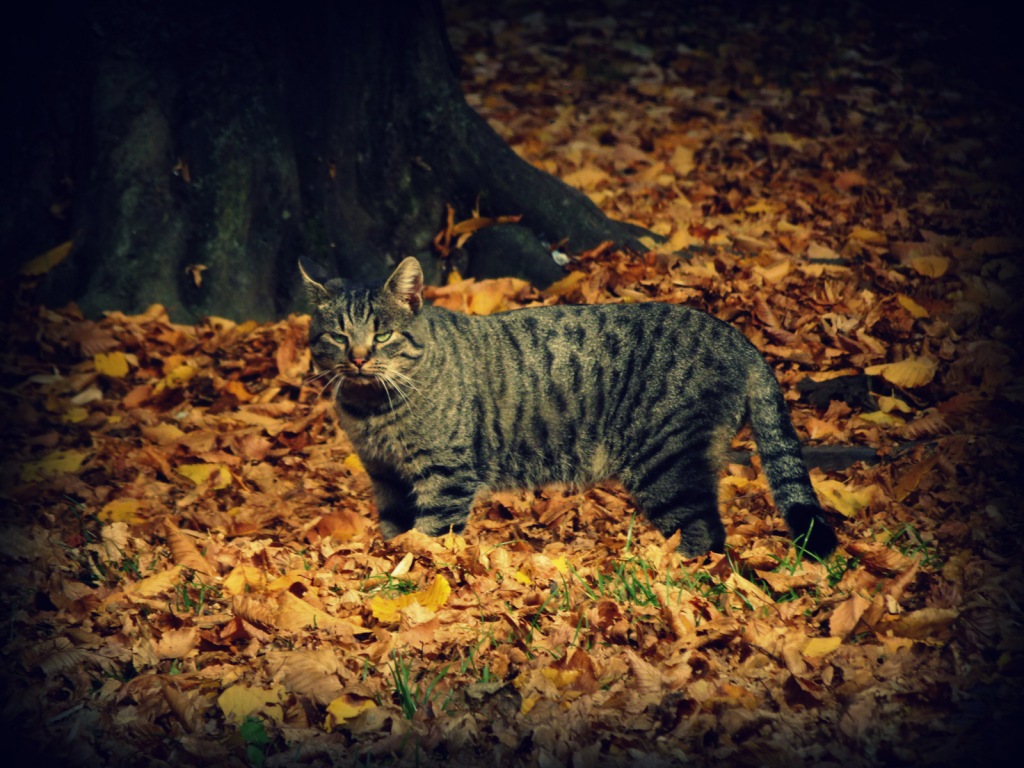



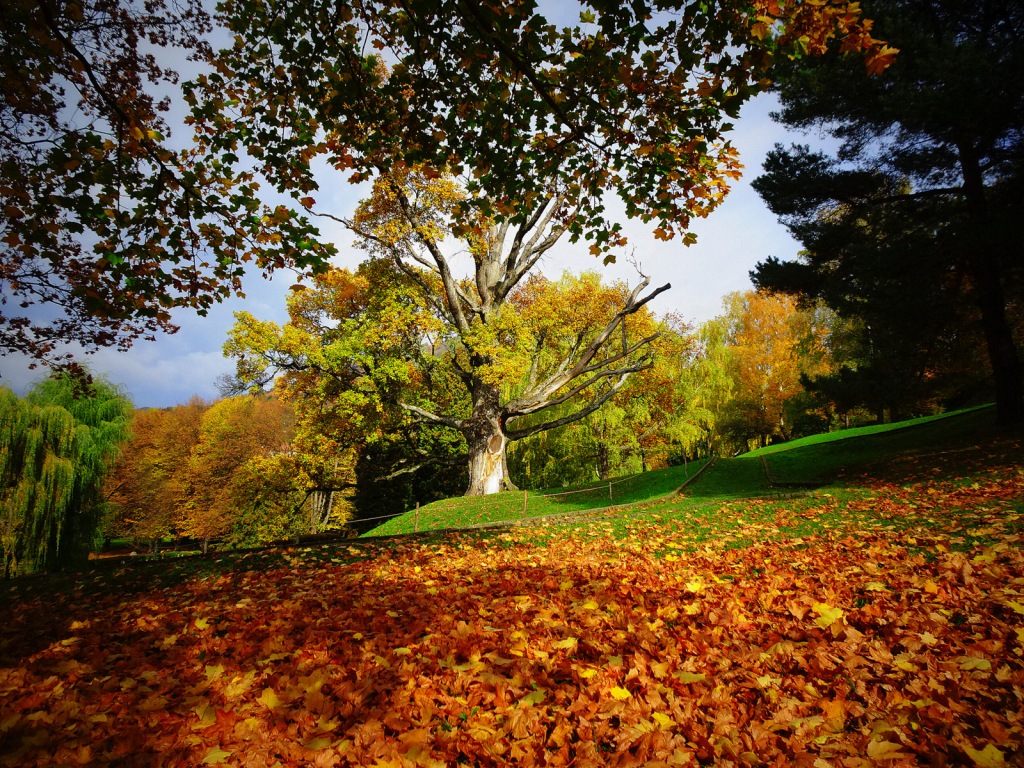

A teacher whispers something to her kindergarten children, and as they – in neat rows of two – walk past the bench I am sitting at, they all wish me “dobrý deň.” And it is a good day indeed. You need such days, when you just read, smoke, enjoy the sun and evade and refuse the dictum of chrematistics. A day on which the phone is turned off and the watch left at home. A day at the end of which you have nothing to show, nothing achieved, nothing accomplished, except that for once, you were happy again.
But don’t worry, in the coming episodes we will delve into history in the usual detailed manner, from Emperor Barbarossa to the Vichy regime, from the Teutonic Order to the Polish-Lithuanian Union.
The next morning, as I’m about to catch the 5:40 bus to Žiar nad Hronom, I see how important mining still is in the region. Most of the connections are marked with hammer and pick and thus reserved for the miners. But the bus driver appreciates me getting up so early and generously lets me board between all the heroes of labor.

So this was the second stop on the “Journey to the Center of Europe”. As with the first center point, I was surprised by how much European history can be found in a small, remote valley.
After that came the winter break, but from spring 2023 on, things will really get going with this huge European project. Have a look at the map and the list of all the places to be visited. If you live near one of these points, I would be happy to meet you!
And the esteemed supporters of this blog will receive a postcard. In St. John’s Chapel, they still had some of these relics from times gone by. Which, unfortunately, is no longer the case is most places.


Do you want a posctard?
Actually, you would be surprised how hard it has become to find postcards in some places. But for you, dear reader, I’ll walk the extra miles!
€10.00
Links:
- The project “Journey to the Center of Europe”.
- More reports from Slovakia. And from Potosí, the South American twin city of Kremnica.
- More hikes and more historical forays.
- If you want to explore Slovakia and its history by hiking, there is the “Trail of the Heroes of the Slovak National Uprising”, a 769-km long hiking path, which also takes you to the geographical center near Kremnica.


I loved Slovakia and Kremnica! Thanks Andreas:)
Thank you!
Ever since I visited Kremnica last October, I have been dreaming of returning and spending more time in Slovakia.
:):)
Spectacular writing and photos! Sooo interesting.
x
Thank you!
I have a feeling that some of the other geographical centers won’t be as beautiful, but I will try to find some interesting stories there, too.
I really hope you get the chance to visit Romania! I recommend the region of Suceava, 6 UNESCO heritage sites. I need to write about it, but there is too much to say.
Hello Stefan,
I have actually been to Romania quite a bit – I even lived in Targu Mures for one year -, but never to Suceava. :-(
I find Romania absolutely beautiful and fascinating, but it’s so huge (and I am such a slow traveller), I can always only cover one small bit on each visit.
I love slow travel but never have the time for that, If you are ever in Suceava I can help with an itinerary. Also really happy you had the chance to live in Romania! Enjoy your travels :D
Thank you very much!
But as I travel so slowly, I don’t really need an itinerary. I usually pick a place (like Suceava) as a base for a week, at least, and then explore the city and the surrounding area from there.
And of course I would also like to go to Cernăuți after/before that, while I am in Bukovina.
Stunning pictures. Well written story. Thank you. 🙏 Still in Berlin or on the road again?
Vielen Dank!
Ich bin noch für 3 Wochen in Berlin.
Nur noch 3 Wochen, muss ich sagen, denn die Zeit läuft schon wieder so verdammt schnell, obwohl ich die meiste Zeit nur um die Seen in Müggelheim laufe.
Aber es würde mich freuen, wenn wir uns noch treffen können!
Dann sollten wir das diese Woche tun. Wetter passt ja. Donnerstag würde passen. Schickst du mir eine PM?
Mache ich sofort!
Absolutely gorgeous photos and I love your commentary. What an amazing undertaking and I’m really looking forward to your next stops! I love hearing about the 5am bus driver and castle worker taking his lunch.
“A day at the end of which you have nothing to show, nothing achieved, nothing accomplished, except that for once, you were happy again.” well said and a great reminder.
Thank you very much!
Yeah, the lady at the castle was very adamant about her lunch hours. :-)
And as for simply enjoying a day out in nature, it was great to remind myself again. I should know it by now, but I am still surprised how easy it sometimes is to have a perfect day.
(I had another one today, walking around the lakes outside of Berlin, sitting down by the water with a book and a cigar, and enjoying the spring sun fighting the February cold, quite successfully so for a few hours.)
You even got a picture of a kitty 😻 All the photos are stunning. Interesting bit of history and a gorgeous day… Thank you for another virtual journey!
Thank you for following the journey!
And there are even two cats.
The one in the park, and one in the center of the square on the first night, when the town looked grey and wet and empty.
I actually went to that park (it’s behind the cinema) several times during my stay, and the cat was there each time.
Your photos, in conjunction with your text, are just SO evocative I can almost smell the cigar! Fantastic – thanks for sharing this journey with us! Jackie x
Some people got so sick from the cigars, they stopped reading my blog. :/